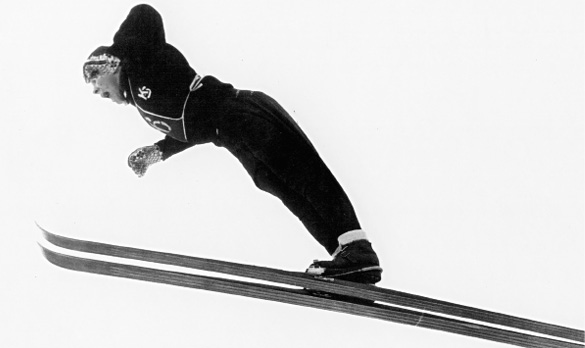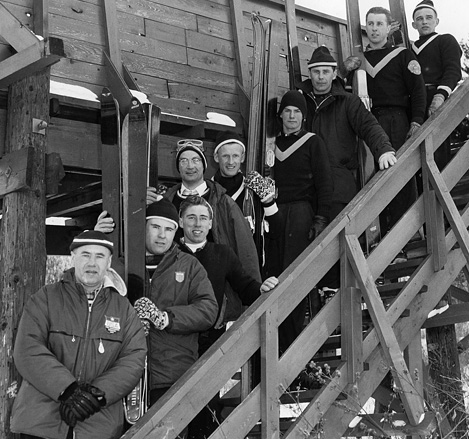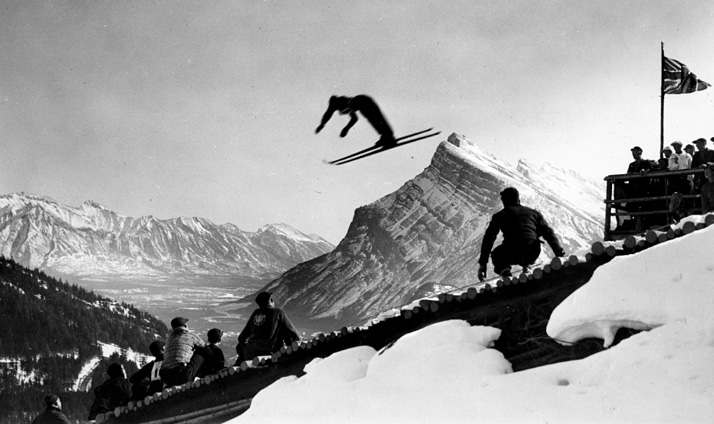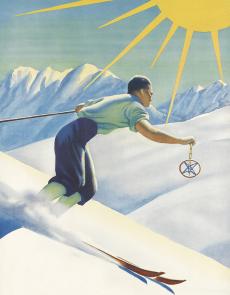SKIING HISTORY
Editor Seth Masia
Managing Editor Greg Ditrinco
Consulting Editor Cindy Hirschfeld
Art Director Edna Baker
Editorial Board
Seth Masia, Chairman
John Allen, Andy Bigford, John Caldwell, Jeremy Davis, Kirby Gilbert, Paul Hooge, Jeff Leich, Bob Soden, Ingrid Wicken
Founding Editors
Morten Lund, Glenn Parkinson
To preserve skiing history and to increase awareness of the sport’s heritage
ISHA Founder
Mason Beekley, 1927–2001
ISHA Board of Directors
Rick Moulton, Chairman
Seth Masia, President
Wini Jones, Vice President
Jeff Blumenfeld, Vice President
John McMurtry, Vice President
Bob Soden (Canada), Treasurer
Einar Sunde, Secretary
Richard Allen, Skip Beitzel, Michael Calderone, Dick Cutler, Ken Hugessen (Canada), David Ingemie, Joe Jay Jalbert, Henri Rivers, Charles Sanders, Christof Thöny (Austria), Ivan Wagner (Switzerland)
Presidential Circle
Christin Cooper, Billy Kidd, Jean-Claude Killy, Bode Miller, Doug Pfeiffer, Penny Pitou, Nancy Greene Raine
Executive Director
Janet White
janet@skiinghistory.org
Membership Services
Laurie Glover
(802) 375-1105
laurie@skiinghistory.org
Corporate Sponsorships
Peter Kirkpatrick
(541) 944-3095
peterk10950@gmail.com
Bimonthly journal and official publication of the International Skiing History Association (ISHA)
Partners: U.S. Ski and Snowboard Hall of Fame | Canadian Ski Museum and Hall of Fame
Alf Engen Ski Museum | North American Snowsports Journalists Association | Swiss Academic Ski Club
Skiing History (USPS No. 16-201, ISSN: 23293659) is published bimonthly by the International Skiing History Association, P.O. Box 1064, Manchester Center, VT 05255.
Periodicals postage paid at Manchester Center, VT and at additional mailing offices. Postmaster: Send address changes to ISHA, P.O. Box 1064, Manchester Center, VT 05255
ISHA is a 501(c)(3) public charity. EIN: 06-1347398
Written permission from the editor is required to reproduce, in any manner, the contents of Skiing History, either in full or in part.
Ragnar Ulland and the Kongsberg Boys
A teenager came to America, embodying the greatest ski jumping tradition of all.
North American skiing owes a lot to Kongsberg, Norway. This silver-mining town, 55 miles southwest of Oslo, dominated ski jumping in the first half of the 20th century. Between 1928 and 1948, of the 12 Olympic medals awarded in ski jumping, Norwegians won 10 (all gold and silver), and six went to Kongsberg boys. Often, three members of a four-man ski jumping team representing Norway were from Kongsberg.
(Photo top: Ragnar Ulland's leap at Mr. Norquay, Alberta, around 1955, appears to clear Mt. Rundle and the town of Banff. Courtesy Ragnar Ulland).
The guys with the red sweaters and white K’s on their chest included Birger, Sigmund and Asbjorn Ruud; Roy and Strand Mikkelsen; Hjalmar Hvam; Petter Hugsted; Arnhold Kongsberg; Nordal Kahldal; Tom Mobraaten; Henry Sodvedt; and Olav, Sigurd and Reidar Ulland.
The Ruuds Led the Way
The Ruud brothers dominated international ski jumping for Norway in the 1930s. Birger won back-to-back gold medals in ski jumping in the 1932 and 1936 Winter Olympics, plus the first Olympic Alpine downhill (not itself a medal event in 1936) and silver in jumping in 1948. He also earned two World Championship golds. In fact, the three Ruud brothers won the World Championships five times among them.
Sigmund won a silver medal in the 1928 St. Moritz Winter Games and Asbjorn won gold at both the 1938 FIS Nordic World Ski Championships and the 1946 Holmenkollen competition. In 1937–38, Birger and Sigmund toured the United States, setting new world records on America’s big hills.
Meanwhile, the Mikkelsen brothers contributed greatly to the development of ski jumping in North America. Strand won the 1929 U.S. National Championships, and younger brother Roy was a member of the 1932 and 1936 U.S. Olympic jumping teams.
Hjalmar Hvam grew up skiing in Kongsberg and came to Portland, Oregon, in 1927. Five years later, he won the first U.S. Nordic combined championship at Lake Tahoe, California, by taking first in Class B jumping and in the 18-kilometer cross-country race. He won several Northwest Alpine and Nordic events in the 1930s and 1940s and also is widely credited with inventing the first commercially successful Alpine release binding.
Petter Hugsted won the junior Holmenkollen championship in 1940 and went on to win a gold medal for Norway in the 1948 Winter Olympic Games.
The trio of Nordal Kaldahl, Henry Sodvedt, and Tom Mobraaten immigrated to British Columbia during the late 1920s and early 1930s. Known as the “three musketeers of ski jumping,” they dominated Northwest jumping events and helped organize, teach and judge skiing competitions throughout Canada.
In 1932, Kaldahl won more than five Class A jumping tournaments in the Northwest. The following year, Mobraaten won most of the same championship events, then joined the Canadian Olympic team in 1936 and 1948. Sodvedt, a champion in the combined Nordic events, was also active in the Canadian Amateur Ski Association, serving as a vice-president, and became a renowned international ski jumping judge.
Seven Ulland Brothers Competed
There were seven Ulland brothers. Sigurd came to the United States in 1928 and set hill jumping records at Lake Placid, New York, and Mount Shasta, California. In 1938, he won the U.S. Ski Jumping Championships in Brattleboro, Vermont.
In 1930, Sigurd’s younger brother Olav took third in the Holmenkollen junior championships. He then coached in France and won the 1935 French four-way championship. In the same year, Olav made jumping history at Ponte di Legno, Italy, where he soared 103.5 meters (339 feet) to become the first ski jumper ever to break the 100-meter barrier. He then coached the Italian jumping team at the 1936 Olympics. The Seattle Ski Club later hired him to coach their young ski jumpers.
Olav settled permanently in Seattle. He won several Class A jumping events in the Pacific Northwest, including the PNSA championships in 1939. Like many jumpers of his time, Olav was also an accomplished Alpine skier and took fifth in the Mount Rainier Silver Skis race of 1938. After years of teaching, he became coach of the 1956 U.S. Olympic ski jumping team, a role he continued through the 1958 World Championships in Lahti, Finland. In 1960, he was named chief of competition for jumping events at the Squaw Valley Olympic Games. Olav is also widely known for his role in the Osborn and Ulland sporting goods stores, a dominant Seattle area ski business from 1941 through 1995.
Olav brought his younger brother Reidar to Seattle in 1947. Reidar immediately found himself a top finisher in jumping tournaments. Four years later he brought his son, Ragnar, then 14, to Seattle.
Ragnar Ulland Continues the Legacy

Ragnar began jumping at age five in Kongsberg. By age eight, he was said to have been jumping from 110 to 120 feet in competitions.
During his first winter in Seattle, Ragnar consistently placed in the top five in Class B regional tournaments. At the 1952 National Junior Ski Jumping Tournament at Lake Tahoe, he took third and also received a prize for the most stylish leap of the day, a 127-foot effort.
Ragnar was said to achieve his amazing distances because he “held his float.” He had learned the technique of carrying skis higher on the float, keeping the air pressure under the blades all the way, leaning forward and then timing his landing to get the last yard, foot and inch. Indeed, the Kongsberg jumpers, starting with Ragnar’s uncle Sigurd, had refined a new style of leaning forward, bending at the hips and keeping the ski tips high on the descent.
During the 1952–53 season, Ragnar notched five first-place finishes, and the next year, at age 16, he began jumping in Class A events, consistently taking second in tournaments, with one first-place title when he beat Uncle Olav. The National Junior Ski Jumping Championships, held in Duluth, Minnesota, in February 1954, were no exception. He placed second, with longer jumps than the local youth, Jerry Lewis, who won the event based on style points.

trainees at Iron Mountain, Michigan,
February 1955.
In the 1954–55 season, Ragnar attended a two-week training camp at Howelsen Hill in Steamboat Springs, Colorado, under coach Gordy Wren. With three jumps at more than 230 feet, he took seventh in Class A events there. A month later, he won the National Junior Ski Jumping Championships at Leavenworth, Washington, and tied the hill record with a standing leap of 284 feet. With that win, he was invited, with 40 other jumpers, to the tryouts for the U.S. Olympic ski jumping team in Iron Mountain, Michigan. He took fourth place and earned a spot on the team.
Olympic Hopes Dashed
Going into the Cortina Olympics, Ragnar was 18, a senior at Seattle’s Roosevelt High School and, at that time, the youngest member of a U.S. ski jumping team to compete in the Olympics.
Before heading for Europe, the team trained at Lake Placid. The intensity there was high, as no American since 1924 had placed better than fifth in Olympic ski jumping. Uncle Olav, as coach of the team, knew European judges were tough on the landing and worked with the jumpers on their style.
In Cortina, the six U.S. jumpers pushed hard in practice, and mishaps occurred. Ragnar took a terrible spill and badly hurt his lower back. He was one of six U.S. winter athletes hurt in one day in Cortina. Disappointed and recovering, Ragnar went home to Seattle. He competed in the local Kongsberger Ski Club annual event, placing second.

left): Art Devlin, Rudi Maki, Dick Rahoi,
Roy Sherwood, Ragnar Ulland and
Billy Olsen.
With the 1956–57 season, tryouts loomed to select the next U.S. team to participate in the FIS World Championships, scheduled for Lahti, Finland, in 1958. Ragnar, now 19, still was recovering from his injuries, and, while he had several top-10 finishes, he finished 17th in the 1957 National Ski Jumping Championships in Berlin, New Hampshire.
In January 1958, he went to Ishpeming for the final tryouts for the 1958 U.S. Team. On the famed Suicide Hill, he repeated his 17th place finish from Nationals the year before. That effort, along with his previous record, was enough to qualify him as an alternate for the Lahti squad.
Later in 1958, he rallied and took third in the PNSA Class A championships at Leavenworth, with a long jump of 283 feet, one foot shy of his previous hill record. Judge Peter Hostmark told the local newspaper that, “The kid’s form was beautiful, better than I’ve seen him display before. I’ve never seen such uniformly good jumping in a Northwest meet.” Ragnar was said to have mastered the new “torpedo” style, with arms held back to augment torso lift.
Near Mt. Hood, Oregon, in March 1958, Ragnar soared 224 feet to set a Multorpor Hill jumping record, winning the Class A Western Open Jumping meet.
At age 21, going into the 1958–59 season, he was still in the running for the U.S. Ski Team and looking ahead to the 1960 Olympics. He had several first and second place finishes at tournaments in the Northwest but finished 14th at the National Championships in Leavenworth. While he missed the 1960 U.S. Team, Ragnar attended the Games as a trial jumper to test hill conditions prior to the official competitions.
Skiing Remains a Way of Life
Ragnar continued to jump through the 1960s, often securing a top-10 finish, but by then he was married and had a young family. He joined Osborn and Ulland on both the wholesale and retail sides of their business. In 1964, he was named manager of the company’s north Seattle store and ran that successful business for many years.
Today, Ragnar is retired in Mt. Vernon, Washington, where he looks back fondly on his ski jumping days. He makes annual trips to Kongsberg to visit relatives and friends, go cross-country skiing and reminisce about being lucky enough to recall the great era of Kongsberg jumpers. And his Multorpor ski hill record of 224 feet still stands. 
Longtime contributor Kirby Gilbert is vice president of the Washington State Ski & Snowboard Museum and Historian of the Ancient Skiers Association.
Table of Contents
WORLD CHAMPIONSHIP ($3,000+)
BerkshireEast/Catamount Mountain Resorts
Gorsuch
Warren and Laurie Miller
Sport Obermeyer
Polartec
CHAMPIONSHIP ($2,000)
Fairbank Group: Bromley, Cranmore, Jiminy Peak
Hickory & Tweed
Rossignol
Snowsports Merchandising Corporation
WORLD CUP ($1,000)
Aspen Skiing Company
Bogner of America
Boyne Mountain Resort
Dale of Norway
Darn Tough Vermont
Dynastar/Lange/Look
Gordini USA Inc/Kombi LTD
Head Wintersports
Intuition Sports
Mammoth Mountain
Marker/Völkl USA
National Ski Areas Association
Outdoor Retailer
Ski Area Management
Ski Country Sports
Sports Specialists Ltd
Sun Valley Resort
Vintage Ski World
World Cup Supply
GOLD MEDAL ($700)
Larson's Ski & Sports
Race Place/Beast Tuning Tools
The Ski Company (Rochester NY)
Thule
SILVER MEDAL ($500)
Alta Ski Area
Boden Architecture PLLC
Dalbello Sports
Deer Valley
EcoSign Mountain Resort Planners
Elan
Fera International
Holiday Valley Resort
Hotronic USA/Wintersteiger
Masterfit Enterprises
McWhorter Driscoll LLC
Metropolitan New York Ski Council
Mt. Bachelor
New Jersey Ski & Snowboard Council
Russell Mace Vacation Homes
SchoellerTextil
Scott Sports
Seirus Innovations
SeniorsSkiing.com
Ski Utah
Steamboat Ski & Resort Corp
Sundance Mountain Resort
Swiss Academic Ski Club
Tecnica Group USA
Timberline Lodge and Ski Area
Trapp Family Lodge
Western Winter Sports Reps Association
World Pro Ski Tour
Yellowstone Club


